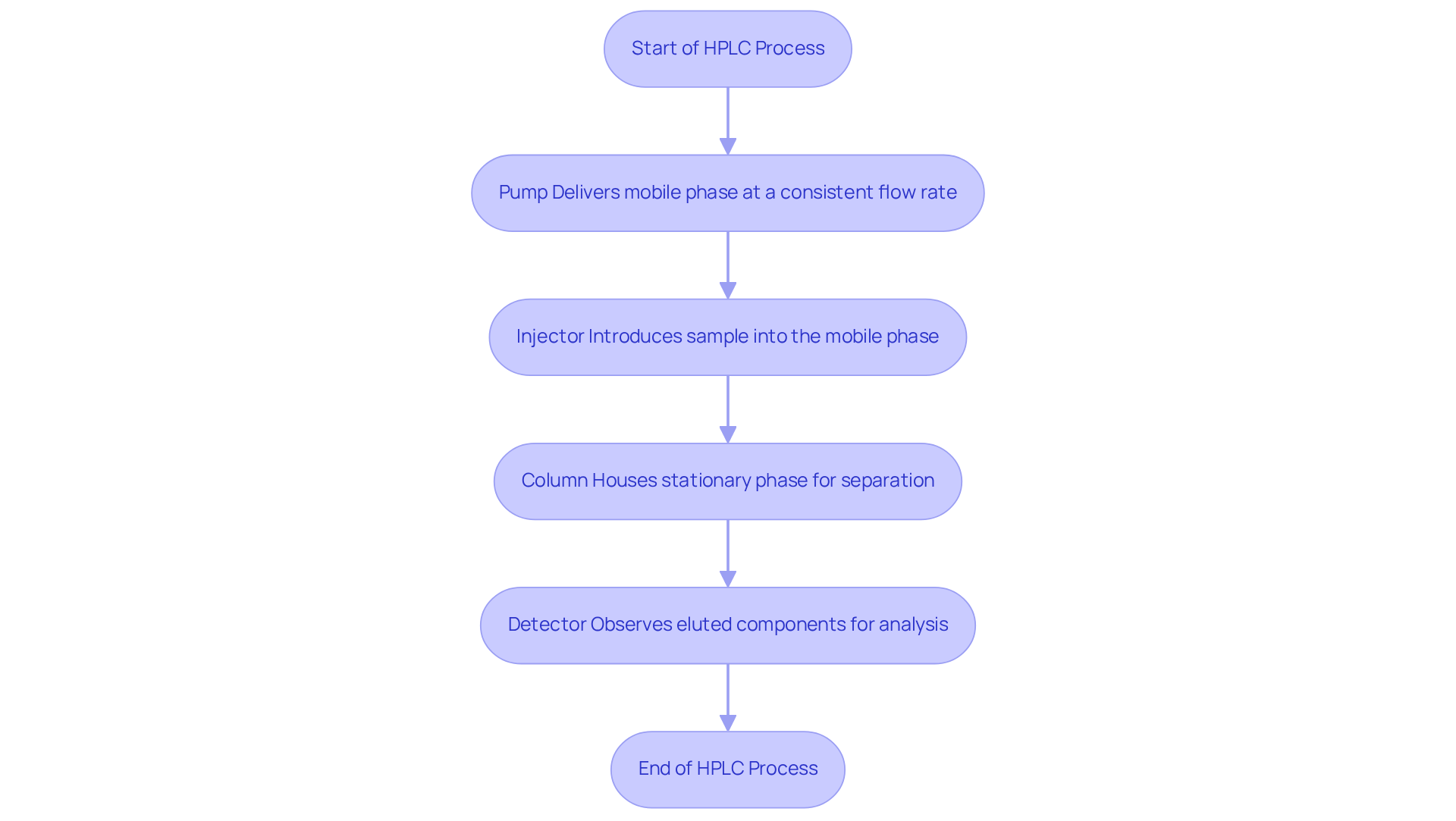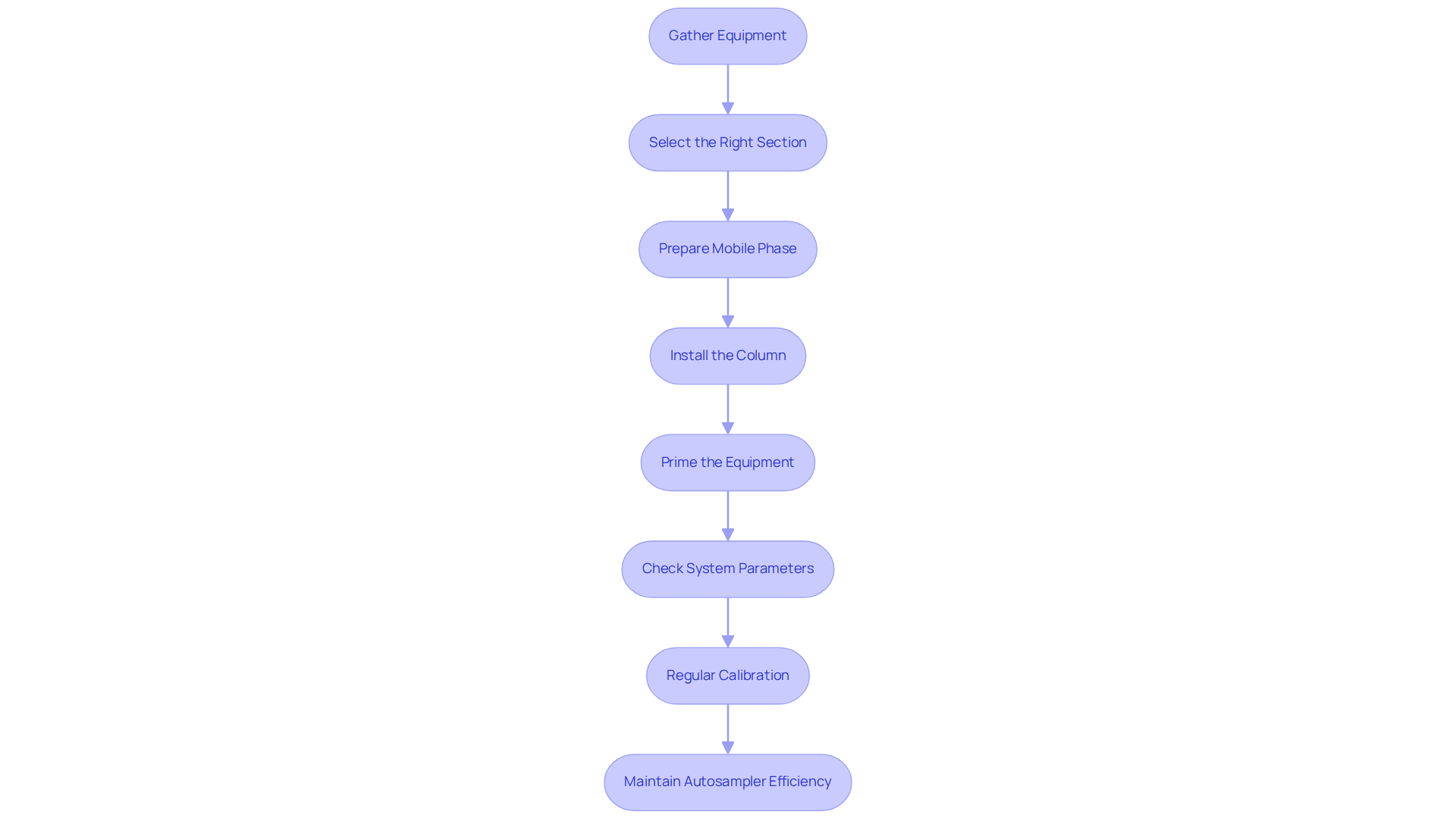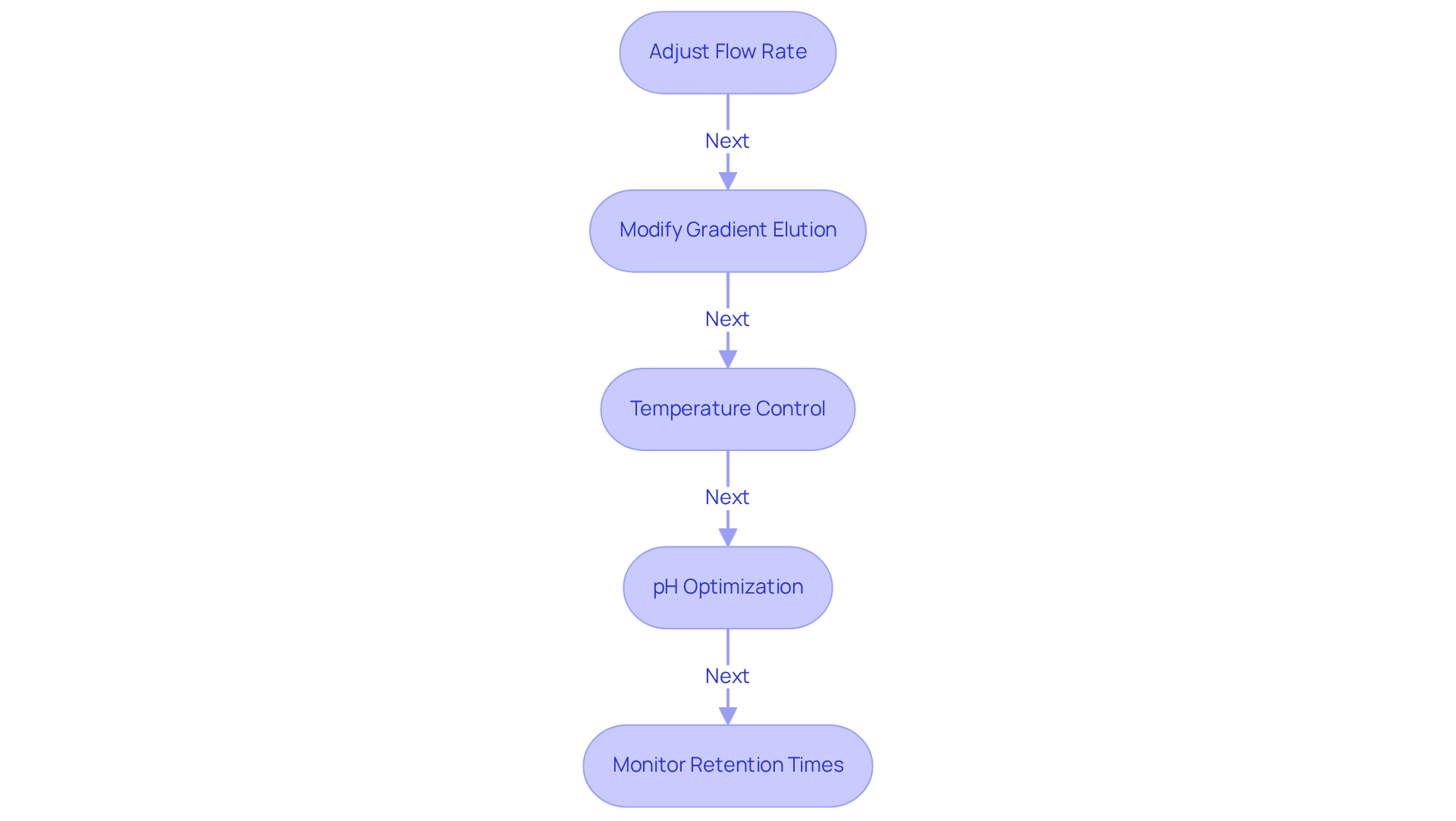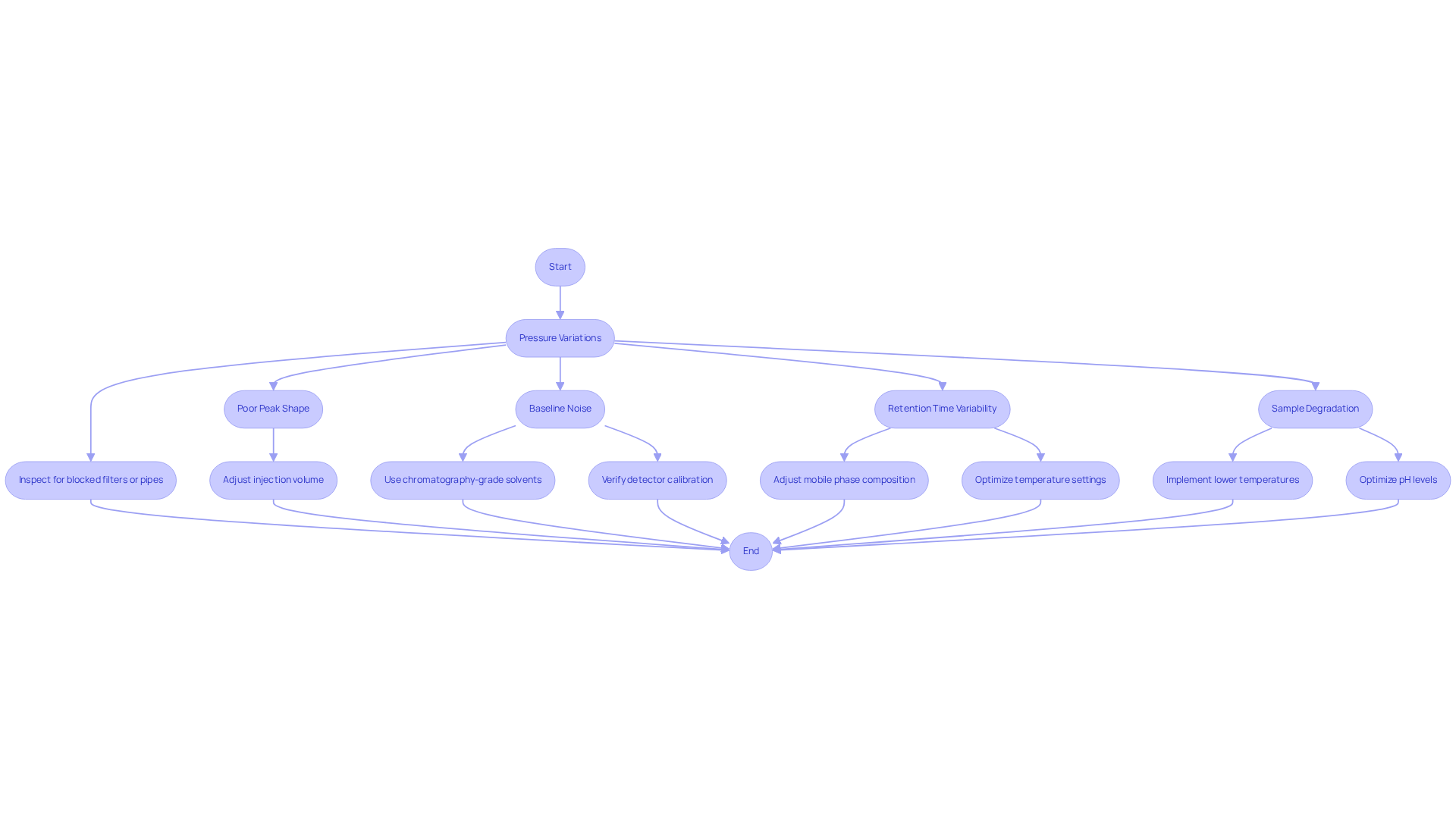Overview
This article provides an authoritative overview of mastering High-Performance Liquid Chromatography (HPLC) for protein purification. It outlines essential steps for setup, optimization, and troubleshooting, capturing the reader's attention by emphasizing the critical role of HPLC in achieving high-quality analytical results.
Understanding HPLC components and parameters is paramount; systematic strategies must be implemented to enhance purification efficiency and effectively address common issues. By doing so, researchers can ensure the integrity of their analytical outcomes.
In conclusion, this comprehensive approach not only reinforces the importance of HPLC in laboratory settings but also encourages practitioners to adopt these practices for improved results.
Introduction
High-Performance Liquid Chromatography (HPLC) stands as a cornerstone technique in protein purification, empowering scientists to achieve unmatched precision in the separation and analysis of complex mixtures.
With the rising demand for high-quality analytical methods, a deep understanding of HPLC's intricacies is vital for researchers looking to enhance their purification processes.
Yet, the challenges associated with HPLC—ranging from parameter optimization to troubleshooting common issues—can often leave practitioners feeling overwhelmed.
What key steps and strategies can transform HPLC into a powerful ally in the pursuit of protein purity?
Understand High-Performance Liquid Chromatography (HPLC)
High-Performance Liquid Chromatography (HPLC) is an essential analytical method for the separation, identification, and quantification of elements within a mixture. This sophisticated process involves passing a liquid sample through a column filled with a stationary phase, while a mobile phase transports the sample along the column. The separation occurs due to the differing interactions between the sample components and the stationary phase, enabling precise analysis.
Key components of an HPLC system are integral to its functionality:
- Pump: This component ensures the mobile phase is delivered at a consistent flow rate, which is crucial for optimal separation.
- Injector: The injector introduces the sample into the mobile phase, facilitating its entry into the system.
- Column: The column houses the stationary phase, where the actual separation of components occurs, making it critical for achieving high resolution.
- Detector: The detector observes the eluted components as they exit the tube, providing real-time data for analysis.
A comprehensive understanding of these elements and their specific roles is vital for diagnosing and enhancing chromatography methods, particularly in HPLC for protein purification processes. JM Science Inc. offers a wide range of high-quality liquid chromatography columns and accessories, including Shodex and CapcellPak columns, designed to improve the effectiveness and reliability of these systems at remarkably competitive prices. Recent advancements in high-performance liquid chromatography technology, such as the emergence of ultra-high performance liquid chromatography (UHPLC), have further elevated these systems, making them indispensable in modern laboratories. The global high-performance liquid chromatography market is projected to grow from $5.23 billion in 2023 to approximately $8.22 billion by 2033, reflecting the increasing demand for precise analytical methods in pharmaceutical and clinical research. This growing need underscores the significance of HPLC for protein purification in achieving high-quality results and various applications.

Prepare for HPLC Setup and Operation
To ensure optimal performance during HPLC setup and operation, it is essential to adhere to the following steps:
- Gather Equipment: Begin by collecting all essential components, including the HPLC system, solvents, materials, and sample preparation tools.
- Select the Right Section: Choose a section specifically designed for protein purification, with C18 reversed-phase sections being the most common option for HPLC for protein purification across a wide range of applications. Be mindful that if retention times are shortened or if there is increased backpressure, it may indicate the need to change the tube.
- Prepare Mobile Phase: Accurately mix solvents, such as water and acetonitrile, in the correct ratio. It is crucial to filter and degas the mobile phase to eliminate air bubbles that could disrupt flow rates.
- Install the Column: Carefully install the column in the HPLC setup, ensuring secure connections to prevent leaks and maintain system integrity.
- Prime the Equipment: Run the mobile phase through the apparatus to eliminate any trapped air and establish a steady flow before sample injection.
- Check System Parameters: Verify that flow rate, pressure, and temperature settings align with your method specifications to ensure accurate results. Conduct daily inspections of pressure and flow rates to preserve overall system health.
- Regular Calibration: Establish a routine for adjusting the chromatography apparatus to ensure consistent results. Calibration should be performed at least monthly for routine work to maintain reliability.
- Maintain Autosampler Efficiency: Clean the injection needle daily to ensure optimal performance of the autosampler.
By implementing these measures, you will prepare your chromatography setup for effective functioning with HPLC for protein purification, which will reduce the likelihood of analytical errors and enhance the reliability of your purification procedures. As Kalvin Chen, co-founder of Mastelf Technologies, aptly states, "A clean high-performance liquid chromatography system is a happy high-performance liquid chromatography system.

Optimize HPLC Parameters for Protein Purification
To optimize HPLC parameters for protein purification, consider the following strategies:
-
Adjust Flow Rate: Experimenting with various flow rates is crucial for identifying the optimal speed for your specific biomolecule. Generally, a slower flow rate enhances resolution but may extend run times. Recent studies indicate that flow rate adjustments can significantly impact separation efficiency, with optimal conditions leading to improved resolution and reduced peak tailing. For instance, the optimal flow rate adjustments can lead to a reduction in variability and enhance reproducibility in results.
-
Modify Gradient Elution: Implementing gradient elution is essential for improving the separation of biomolecules. Begin with a low concentration of organic solvent and gradually increase it to elute proteins based on their hydrophobicity. This technique has been shown to effectively separate complex mixtures, achieving robust results in under 20 minutes. Successful examples include the gradient-elution HILIC method for olanzapine, which showcases the effectiveness of this strategy.
-
Temperature Control: Modifying the temperature of the tube can significantly enhance separation efficiency. Higher temperatures reduce viscosity, facilitating better mass transfer and faster elution. For instance, maintaining a column temperature around 30°C has been associated with optimal performance in various applications, particularly when using HPLC for protein purification, with studies indicating that temperatures in the range of 25 °C, 30 °C, and 35 °C can yield significant improvements.
-
pH Optimization: The pH of the mobile phase plays a critical role in influencing the charge and solubility of proteins. Testing various pH levels can assist in determining the ideal conditions for your desired molecule, improving its stability and separation. Studies have demonstrated that slight pH adjustments can lead to significant improvements in retention times and peak shapes.
-
Monitor Retention Times: Keeping track of retention durations for your substances of interest is vital. By systematically adjusting parameters based on these observations, you can achieve the desired separation and improve overall method reliability. Statistical analyses have shown that consistent monitoring can lead to a reduction in variability and enhance reproducibility in results.
By systematically optimizing these parameters, you can significantly enhance the efficiency and effectiveness of your purification process, ensuring high-quality outcomes in your analytical endeavors.

Troubleshoot Common HPLC Issues in Protein Purification
When encountering issues during HPLC for protein purification, it is essential to consider effective troubleshooting strategies.
-
Pressure Variations: Inconsistent pressure readings may indicate obstructions within the system. Inspect for blocked filters or pipes to ensure smooth operation.
-
Poor Peak Shape: Broad or tailing peaks can compromise results. Ensure proper sample preparation and avoid column overload by adjusting the injection volume as necessary.
-
Baseline Noise: High baseline noise often stems from impurities in solvents or incorrect detector settings. Use chromatography-grade solvents and verify that the detector is calibrated correctly to minimize interference.
-
Retention Time Variability: Inconsistent retention times may arise from fluctuations in mobile phase composition or temperature. Regularly adjust your high-performance liquid chromatography system to maintain precision.
-
Sample Degradation: If substances are degrading during the process, consider implementing lower temperatures or optimizing pH levels to enhance stability.
By diligently following these troubleshooting steps, you can effectively address common HPLC issues and facilitate HPLC for protein purification.

Conclusion
High-Performance Liquid Chromatography (HPLC) is a cornerstone technique in protein purification, enabling researchers to achieve precise separation and analysis of complex mixtures. Mastery of HPLC enhances the efficiency of purification processes and ensures high-quality results critical in various scientific fields, including pharmaceuticals and clinical research.
This article outlines essential steps for successful HPLC application, beginning with an understanding of its fundamental components and setup, and progressing to the optimization of various parameters for improved performance. Key strategies include:
- Adjusting flow rates
- Modifying gradient elution
- Controlling temperature and pH
These strategies are vital for achieving optimal separation and minimizing operational errors. Furthermore, troubleshooting common issues is essential to ensure the HPLC system operates smoothly, thereby enhancing the reliability of the purification process.
In conclusion, the significance of HPLC in protein purification cannot be overstated. As the demand for precise analytical techniques continues to grow, mastering HPLC empowers researchers to navigate the complexities of protein analysis effectively. Embracing these methodologies leads to better experimental outcomes and contributes to advancements in biochemistry and related fields. By implementing the best practices outlined, professionals can ensure their HPLC systems yield the most accurate and reproducible results possible.




